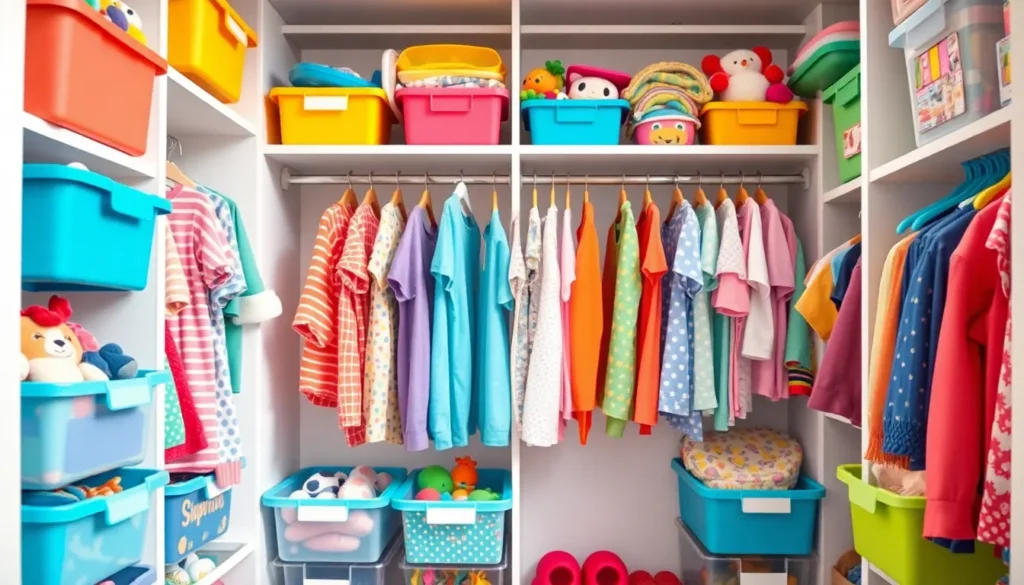Table of Contents
ToggleEvery parent knows that a kid’s closet can quickly turn into a chaotic black hole of clothes, toys, and who-knows-what-else. With a little creativity and some clever organization strategies, it doesn’t have to be a disaster zone. Imagine opening that closet door and feeling a sense of calm wash over you instead of a wave of dread. It’s time to transform that cluttered space into a well-organized haven.
Creative Kids Closet Organization Ideas
Utilizing vertical space maximizes storage in kids’ closets. Consider adding shelves for books and toys. Incorporating clear bins allows for easy visibility of stored items. Install hooks on the walls to hang bags and accessories, freeing up floor space.
Using colorful bins or baskets can make organizing fun for children. The visual appeal engages kids in the process, encouraging them to maintain order. Labeling containers helps children identify where items belong, teaching responsibility and organization.
Utilizing dividers within drawers separates clothes by type or season. Organizing items this way provides quick access during busy mornings. Creating a rotating seasonal wardrobe can simplify choices and reduce clutter.
Incorporating a rod for hanging clothes can optimize limited space. Adjustable hanging rods accommodate growth, adapting to children’s needs over time. Hanging organizers for shoes or accessories can maximize storage efficiency, maintaining the closet’s neat appearance.
Creating a fun display for frequently used items can motivate children to keep their space organized. Consider using corkboards for displaying art and achievements, making the closet more personal and engaging.
Combining these strategies creates a functional and inviting kids’ closet. A well-organized closet promotes independence and self-management in children. Enabling them to take part in the organization process fosters a sense of ownership and pride.
Benefits Of Organized Closets

Organized closets provide numerous advantages for both children and parents. Decluttering creates a more enjoyable space, streamlining daily routines and enhancing productivity.
Reduced Clutter
Reduced clutter simplifies everyday life and fosters a calming environment. More often than not, open spaces promote creativity while minimizing distractions. A well-organized closet allows children to develop habits that prioritize tidiness, teaching responsibility. Statistics show that children are less likely to misplace items when they have designated spaces for belongings. Studies suggest that a tidy environment can enhance focus and reduce anxiety, making it essential for optimal development.
Easier Access To Clothing
Easier access to clothing helps children become independent in their daily choices. Children can select outfits without assistance when everything is visible and well-organized. Designed systems, such as low-hanging rods or labeled bins, facilitate quick retrieval of clothing and accessories. More importantly, easy access encourages children to take responsibility for their belongings, fostering a sense of ownership. Research indicates that when kids can choose outfits on their own, they develop confidence and styling skills, which are beneficial for their personal growth.
Practical Organization Solutions
Effective organization strategies can transform children’s closets into functional spaces. Utilizing the right tools makes it easier for kids to maintain order.
Use Of Clear Bins
Clear bins simplify organization by providing visibility for stored items. Boxes can be stacked neatly on shelves, maximizing vertical space. Children recognize toys and clothes at a glance, promoting independent selection. Opting for various sizes accommodates different types of items, from shoes to books. Bins minimize clutter while creating a visually appealing setup, keeping the closet tidy and encouraging kids to participate in upkeep.
Labels For Easy Identification
Labels enhance accessibility by ensuring items are easy to find. Labeling bins and drawers helps children learn where things belong. Using colorful labels creates an engaging aspect that motivates kids to organize. Employing consistent categories aids in maintaining this system, such as separating clothes by type or season. This method encourages responsibility and fosters independence as kids can confidently locate and return items.
Seasonal Organization Tips
Seasonal organization provides an efficient way to manage children’s closets. Implementing these strategies makes it simpler to keep garments accessible and organized.
Rotate Clothing Seasonally
Rotating clothing seasonally ensures that children wear appropriate items for the current weather. Store winter coats, heavy sweaters, and boots in a designated area during warmer months. Overflowing closets become manageable by packing away off-season clothes in labeled bins. Labeling bins with specific seasons aids quick identification when it’s time to switch. Encourage children to choose outfits from the current season, making it easier for them to find what they need. Instilling this habit builds awareness around seasonal changes and promotes organization skills.
Store Outgrown Clothes
Storing outgrown clothes prevents clutter and provides a streamlined closet experience. Designate a space for items no longer fitting, which can include a bin or a shelf in a closet. Donate or sell clothes that are still in good condition, as it reduces the volume of items to store. Before storing, wash and neatly fold clothing to maintain its condition. Utilize clear bins or bags to see what items are available for younger siblings or future use. This practice teaches children about recycling and keeping their space uncluttered.
Fun And Engaging Storage Options
Organizing a child’s closet can be fun with attractive and engaging storage ideas. Implementing creative solutions encourages children to take responsibility for their belongings.
Color-Coded Hangers
Color-coded hangers offer a visually appealing way to organize clothes. Assigning specific colors for each child helps them quickly identify their items. Consider using different colors for seasonal clothing, making it easier for kids to find what they need. Additionally, organizing by color creates a vibrant display that transforms the closet into an engaging space. Choosing hangers that match the child’s personality adds a personal touch, enhancing motivation to keep things tidy.
Themed Storage Bins
Themed storage bins provide an excellent method for organizing toys and accessories. Selecting bins that reflect a child’s interests, such as animals, superheroes, or favorite colors, makes storage fun. Placing labels on each bin assists with easy identification, encouraging children to put items back after use. Using bins in different sizes allows for flexibility in storing various items, ensuring everything has a place. Grouping similar items in themed bins maintains organization and sparks creative play, keeping the closet clutter-free.
Transforming a child’s closet into an organized space not only alleviates clutter but also empowers children to take charge of their belongings. By implementing creative strategies like using clear bins and colorful labels, parents can make the organization process engaging and educational. Seasonal rotation of clothing and designated storage for outgrown items further enhances the closet’s functionality.
These practices cultivate independence and responsibility in children while fostering a sense of pride in their personal space. An organized closet ultimately leads to smoother daily routines and a more enjoyable environment for both kids and parents. Investing time in closet organization pays off in the long run, creating a space that inspires creativity and promotes lifelong habits of tidiness.







